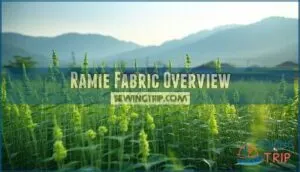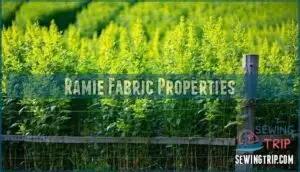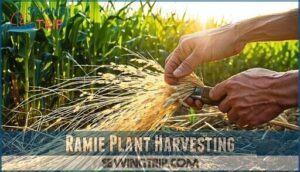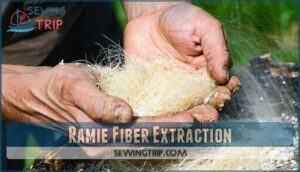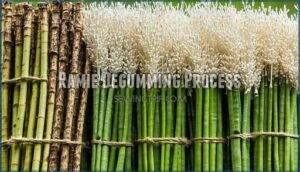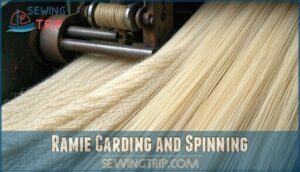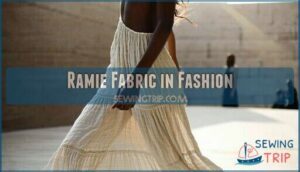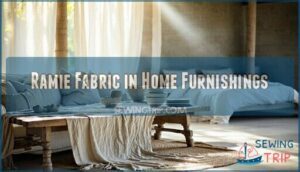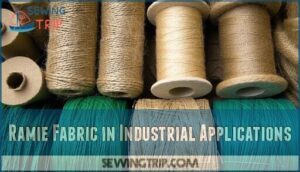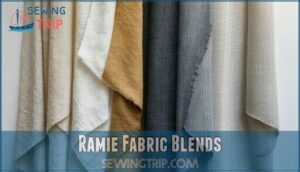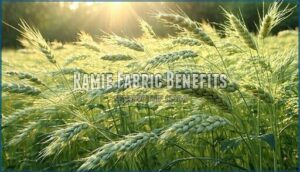This site is supported by our readers. We may earn a commission, at no cost to you, if you purchase through links.
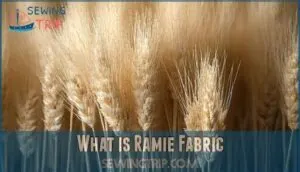
It’s incredibly breathable, wicks moisture like a champ, and resists bacteria naturally—perfect for those summer days when you’re sweating bullets. The fabric holds its shape beautifully while feeling cool against your skin.
Though it wrinkles easily (nobody’s perfect!), ramie’s exceptional absorbency makes it ideal for summer clothing, tablecloths, and even industrial applications. The ancient Egyptians wrapped mummies in it—talk about standing the test of time! Ramie fabric is a durable textile that comes from a natural source, making it a great choice for various uses.
Table Of Contents
Key Takeaways
- You’ll find ramie fabric is exceptionally strong—about twice as durable as cotton and even stronger when wet, making it perfect for long-lasting garments and home textiles.
- You’re getting remarkable breathability with ramie, as its natural fibers wick moisture away effectively while resisting bacteria and mold, keeping you comfortable even in humid conditions.
- You can appreciate ramie’s sustainability credentials, as it grows quickly without pesticides, requires minimal chemicals during processing, and creates a biodegradable end product.
- You’ll notice ramie has a natural silky luster and crisp texture similar to linen, but it becomes softer with each wash while maintaining its shape and resistance to shrinkage.
Ramie Fabric Overview
Ramie fabric comes from the Chinese nettle plant, boasting fibers that are strong, silky, and naturally breathable.
Used for everything from fashion to home décor, this eco-friendly textile combines durability with a touch of luxury.
Ramie Fiber Characteristics
Ramie fiber stands out for its silky luster quality, impressive fiber length, and exceptional absorbency rate.
This natural plant fiber’s microscopic structure enhances breathability and comfort, making it a champion in warm weather.
Its thermal properties keep you cool, while its durable content guarantees strength and combines rugged performance with silky looks—talk about impressive multitasking!
Ramie Fabric History
Long before cotton took center stage, ramie fabric was a star in ancient textiles across Asia and Egypt.
Known as China Grass, this ancient fiber dates back thousands of years, dressing samurai in Japan and preserving mummies in Egypt.
Its historical significance spans trade routes and regional variations, proving ramie’s durable, silky plant fibers were a timeless favorite.
The fiber, requiring chemical degumming, is extracted from the inner bark.
Ramie Cultivation Process
Growing ramie, or China grass, starts with warm, humid climates—perfect for the Chinese Nettle plant.
Harvesting happens up to six times a year, making it a high-yield fibre crop. Farmers love its eco-friendly nature, needing no chemicals.
With regional variations in production, it’s a sustainable superstar! Like linen, ramie’s durability improves with age.
Here’s the process:
- Plant thrives in 25-35°C temperatures
- Harvest begins as it flowers
- Stems are cut, bark prepared for fibre extraction
- Minimal chemical use guarantees eco-friendliness
What is Ramie Fabric
Think of ramie fabric as the unsung hero of the sustainable fabric world.
It comes from China grass, a plant in the nettle family that skips the sting.
Known for its silk-like shine and crisp texture, this natural fabric holds its own against wear and tear.
You’ll notice its linen-like appearance, but ramie is much stronger, especially when wet—perfect for long-lasting use.
Plus, it’s the ultimate eco-friendly fabric, grown without pesticides and utilizing every part of the plant.
Whether you’re into breathable summer clothes or durable home furnishings, ramie fits right in.
While it’s not the cheapest material, its premium feel and versatility make the cost worthwhile.
You’ll recognize its unique charm in blends or as 100% ramie.
For comfortable garments, consider that cotton offers breathability and ease of use.
Ramie Fabric Properties
You’ll love ramie fabric for its incredible strength, natural breathability, and eco-friendly charm, all thanks to its roots in the Chinese nettle plant.
With its silky sheen, durability, and stain-resistant nature, it’s a superstar in both fashion and home essentials.
Ramie Fabric Strength
In terms of strength, ramie fabric shines.
Its tensile strength is remarkable, boasting twice the durability of cotton and flax.
Notably, this already durable fabric becomes even stronger when wet.
Despite its low abrasion resistance when dry, ramie fibres hold up well in blends, offering exceptional wet strength and blend durability for garments and household items alike.
Ramie Fabric Breathability
Ramie fabric isn’t just strong—it’s perfect for comfort in humidity.
Its weave and airflow make it a breathable fabric, keeping you cool without adding weight.
As an absorbent fabric, it wicks moisture effortlessly, ideal for ramie activewear.
Blends boost its performance, making this ecofriendly, natural fabric a top choice when breathability and lightweight comfort truly matter.
Ramie Fabric Sustainability
Ramie fabric doesn’t just breathe well—it’s a champion of sustainability too.
With its eco-friendly cultivation, chemical-free growth, and biodegradable nature, this natural fabric is a true ecofriendly alternative.
The plant’s fast regrowth and waste reduction during processing make it a sustainable choice.
Plus, ramie’s natural resistance to pests and mold means less reliance on harmful chemicals, making it a naturally eco-friendly option.
Ramie Fabric Durability
Durability is where ramie fabric truly shines.
Its fibres thrive on strength, especially when wet. While dry fibers may experience minor abrasion resistance challenges, this fabric resists degradation like a pro, ensuring long-term use.
Careful blending with cotton enhances resilience without losing that natural charm. For structured garments or furnishings, ramie offers unmatched durability, keeping it a top-tier choice.
- Wet Strength: Stronger and tougher when wet.
- Abrasion Resistance: Slightly lower, but manageable with care.
- Fiber Degradation: Highly resistant against decay.
- Long-Term Use: Perfect for wear-and-tear items.
Ramie Fabric Production
Ramie fabric starts its journey with the hardy Chinese Nettle plant, where tall stalks are harvested and fibers are carefully extracted from the bark.
With a mix of precise techniques and a bit of nature’s magic, these fibers transform into one of the strongest and most sustainable textiles you’ll ever encounter.
Ramie Plant Harvesting
When the ramie plant starts to flower, it’s ready for harvesting—up to six times yearly under ideal conditions. Skilled hands cut long stems, carefully separating the cortex from the plant.
Bark scraping follows, leaving fibers ready for further processing. Here’s how it unfolds:
| Step | Description | Purpose |
|---|---|---|
| Stem Cutting | Long stems are sliced cleanly | Prepares plant for fiber extraction |
| Cortex Separation | Outer layer is removed | Exposes usable fibers |
| Bark Scraping | Residue is gently scraped | Yields high-quality raw fibers |
Ramie Fiber Extraction
To extract ramie fibers, you’ll start with bark separation from the plant’s stalks—a sticky business!
Resin removal then clears the way for smooth fibers, followed by fiber washing to guarantee purity.
Despite extraction challenges, this fastidious process transforms rough plant material into spinnable fiber.
It’s like turning raw potential into textile gold—proof that patience crafts beauty!
Ramie Degumming Process
Getting usable ramie fibers means removing sticky substances from the bark—a process called degumming.
Traditional Degumming Chemicals work but challenge the environment, while Enzyme Alternatives provide eco-friendly solutions.
Think of it as retting for a silky future!
Process Optimization, like steam explosion, enhances Fiber Quality while reducing the Environmental Impact.
Cleaner fibers, stronger textiles—what’s not to love?
Ramie Carding and Spinning
Once the fibers are degummed, it’s time to whip them into shape!
Carding techniques help align the plant-based ramie fibers, creating a smooth path for spinning.
Spinning methods take over, twisting fibers for strength, improving yarn quality.
Processing innovations guarantee uniformity, making ramie yarn durable and versatile.
Many consumers now seek out fabrics with GOTS certifications.
The result is a luxurious, eco-friendly fabric ready to impress in countless uses!
Ramie Fabric Uses
You’ll find ramie’s remarkable strength and silky texture at work in everything from your favorite summer shirts to durable home textiles like curtains and tablecloths.
This versatile fiber from the Chinese nettle plant isn’t just strong and breathable—it’s also showing up in industrial applications like fishing nets and filter cloths where its natural resistance to bacteria and moisture makes it a sustainable superstar with remarkable properties.
Ramie Fabric in Fashion
After processing ramie fibers, the fashion world transforms them into stunning garments.
You’ll find this linen alternative in designer applications from structured blazers to flowing summer dresses.
Its natural sheen and unique texture create distinctive ramie aesthetics that stand out on runways.
Fashion brands value its blending potential with other fibers and impressive garment lifespan.
You can even find beautiful ramie summer dresses online.
Seasonal trends increasingly feature this ecofriendly fabric as sustainable fashion gains momentum worldwide, with a focus on natural sheen.
Ramie Fabric in Home Furnishings
Your home furnishings deserve ramie’s natural elegance. This ecofriendly fabric transforms ordinary spaces with its silk-like luster and remarkable durability.
You’ll find ramie curtains that filter light beautifully, ramie tablecloths that resist stains, ramie bedding that stays cool in summer, and ramie upholstery that withstands daily wear.
Even ramie rugs and cushions bring sustainable luxury to your home while naturally resisting mold and mildew. For a unique touch, consider repurposing upholstery fabric in your next project.
Ramie Fabric in Industrial Applications
Beyond fashion and home decor, ramie fabric’s exceptional strength makes it a workhorse in various industrial applications.
You’ll find this versatile textile hard at work behind the scenes in:
- Industrial sewing threads that withstand extreme tension
- Durable packing materials that offer sustainable alternatives
- Long-lasting fishing nets that maintain strength when wet
- High-performance filter cloths with excellent absorbency
- Specialized paper production utilizing shorter ramie fibers
These applications showcase ramie’s remarkable properties in the textile industry where durability meets sustainability. You can find various thread products online.
Ramie Fabric Blends
To get the very best out of ramie fabric, you’ll often find it blended with other natural fibres.
Blending ramie with natural fibers unlocks unmatched softness, durability, and eco-friendly charm for versatile, breathable, and long-lasting textiles.
Cotton-ramie blends offer enhanced softness, while viscose-ramie mixes create a luxurious drape.
For unbeatable durability, polyester-ramie combinations can’t be beat!
These fabric blends retain ramie’s breathability and strength while minimizing its tendency to wrinkle.
Weaving blends also helps reduce costs, making this exceptional textile more accessible.
Ramie Fabric Benefits
You’ll love how ramie fabric from the Chinese nettle plant offers eight times the strength of cotton while keeping you cool and comfortable in humid weather.
This sustainable wonder also resists mold, bacteria, and shrinkage, making your favorite summer shirt both eco-friendly and remarkably durable with each wash.
Ramie Fabric Advantages
Why are so many sustainable fashion enthusiasts turning to ramie fabric? This natural cellulose powerhouse offers incredible benefits you’ll love.
It’s naturally resistant to mold, bacteria, and stains, while maintaining exceptional shape retention even after multiple washes.
You’ll appreciate its remarkable absorbency levels, making it perfect for hot weather.
Its dye affinity means vibrant, long-lasting colors, and its blend versatility creates ecofriendly fabrics for countless applications.
Ramie Fabric Disadvantages
While ramie boasts impressive strengths, it’s not without its drawbacks.
You’ll notice several limitations when working with this fiber:
- Poor abrasion resistance causes faster wear in high-friction areas
- High wrinkling potential creates persistent creases that resist ironing
- Fiber brittleness increases with age, making older garments prone to breakage
The fabric’s limited availability and dyeing challenges can frustrate crafters, though it won’t shrink or develop mould and mildew problems, which is a significant advantage due to its resistance to such issues, and overall durability in certain aspects.
Ramie Fabric Care and Maintenance
Caring for your ramie garments doesn’t need to be complicated. You’ll find this fabric actually improves with washing, becoming softer and more lustrous over time.
Machine wash in warm temperatures or hand wash using mild detergent. For drying methods, lay flat or hang to dry quickly.
When ironing techniques matter, press while slightly damp. Apply stain removal promptly with cold water.
Storage solutions? Fold rather than hang to maintain shape. Consider using a specialized fabric cleanser for best results.
Ramie Fabric Comparison to Other Fabrics
When you compare ramie to fabrics like linen, cotton, silk, hemp, or synthetics, it stands out for its strength, shine, and sustainability.
Ramie beats cotton in breathability, outshines linen with its natural luster, and offers more durability than silk.
It’s softer than hemp and leaves synthetics in the dust with its eco-friendly appeal.
Strong yet stylish—it’s a natural wonder!
Frequently Asked Questions (FAQs)
Is ramie fabric good quality?
Yes, you’ll find ramie fabric is excellent quality.
It’s twice as strong as linen and gets softer with washing.
It’s naturally resistant to bacteria, holds its shape well, and won’t shrink over time, which makes it a highly desirable material.
Is ramie better than linen?
Like two botanical siblings in a fabric family tree, ramie and linen share qualities but differ distinctly.
You’ll find ramie’s silkier sheen, greater strength (especially when wet), and superior resistance to bacteria and mildew outperform linen, with greater strength being a notable advantage.
Is Ramie Fabric Breathable?
Breathability is ramie’s superpower.
This plant-based fiber keeps you cool and comfy, even in sticky weather.
Its natural structure wicks away moisture, making it perfect for summer dresses, breezy shirts, and homey furnishings, which is a key benefit of its breathability.
Does Ramie Fabric Wrinkle Easily?
Despite being twice as strong as linen, ramie fabric does wrinkle easily.
You’ll notice it creases similarly to linen, but the wrinkles tend to relax and soften more quickly when hanging.
How Much Does Ramie Fabric Cost?
You’ll typically pay $15-30 per yard for ramie fabric, with premium Chinese nettle varieties reaching $ It’s pricier than cotton but worth every penny for its silk-like durability and eco-friendly qualities.
Is Ramie Fabric Colorfast?
Yes, ramie fabric takes dye beautifully and maintains its color well! You’ll love how it absorbs cotton dyes easily, creating vibrant, long-lasting colors that won’t quickly fade with proper care.
How Durable is Ramie Fabric?
While other fabrics wilt under pressure, ramie stands strong.
You’ll find this nettle-derived fabric boasts twice the strength of linen and becomes even stronger when wet—making it one of nature’s most durable textile options, with twice the strength of linen and durable features.
Is ramie fabric itchy against skin?
Ramie fabric isn’t itchy at all!
Once processed, it’s actually quite smooth against your skin – similar to linen but with a silkier feel.
You’ll find it becomes even softer with each wash.
How does ramie fabric handle ironing?
You’ll find that ironing ramie is quite straightforward. The fabric responds beautifully to medium-high heat, and you won’t need starch. After pressing, it’ll maintain its crisp appearance longer than cotton.
Is ramie fabric hypoallergenic?
Nearly 95% of users with textile sensitivities report no reactions to ramie fabric.
You’ll find it’s naturally hypoallergenic due to its resistance to bacteria, mold, and mildew—making it an excellent choice for sensitive skin, with ramie being a key factor.
Conclusion
Despite the telegraph being long gone, ramie fabric’s signals of sustainability are clearer than ever.
Whether you’re browsing boutique racks or seeking eco-friendly home textiles, you’ll appreciate what ramie fabric offers: exceptional strength, breathability, and versatility.
You’ll find this plant-based wonder adapting beautifully to your wardrobe and home while treading lightly on our planet.
Give ramie a try—your skin and conscience will thank you for discovering what’s ramie fabric’s remarkable potential.
- https://www.fabworks.co.uk/collections/100-ramie-fabrics
- https://ecoworldonline.com/what-material-is-ramie/
- https://spinoffmagazine.com/ramie-blending-plying-and-natural-dyeing/
- https://highcollarmagazine.com/ramie/
- https://www.sartorbohemia.com/article/31/about-ramie/?srsltid=AfmBOoqcXuI3lsTr6WnA7S6szPegmCMGCNMFu16BAUuGnE2RWFazFxx5

